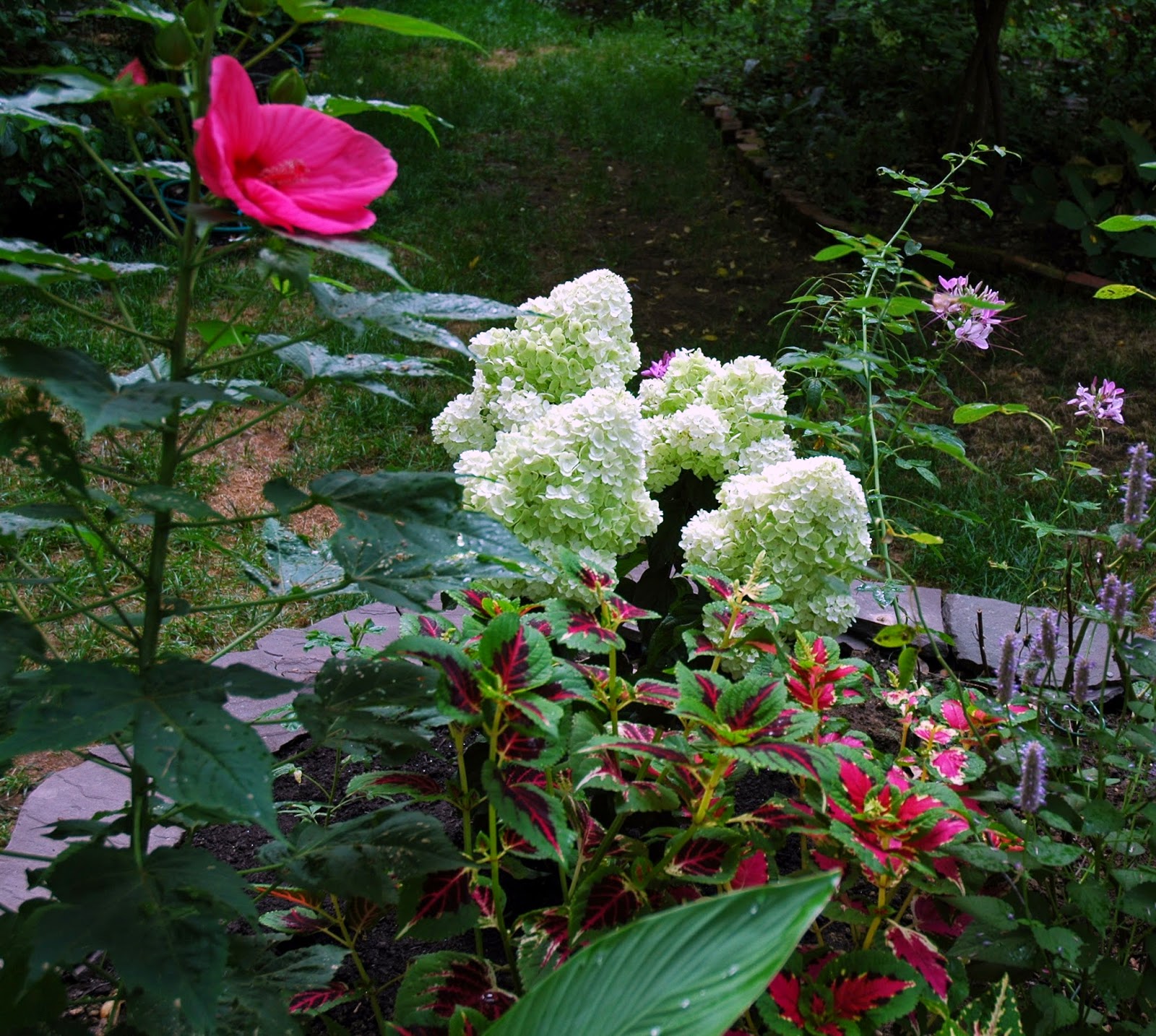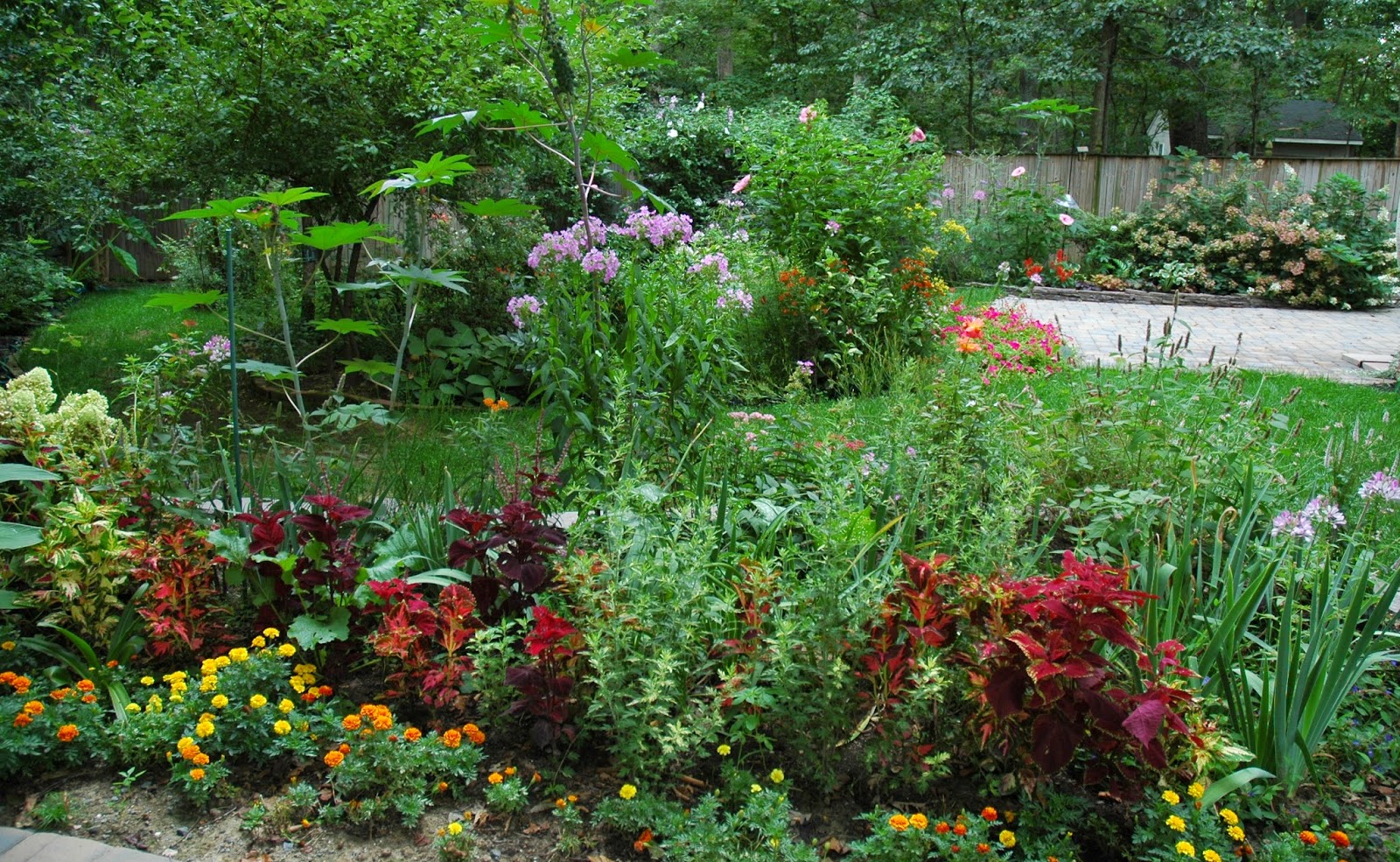The brutal winter of 2014 was quite hard on our hydrangeas. All of our Macrophylla died back completely to the ground. Also, our Quercifolia had to be moved due to construction. Needless to say, this hydrangea post will not be as copious as last year. Our wish is for a less frigid winter in early 2015!

Despite the note above, our paniculata Little Lamb performed very well this year. Paniculata prefer more sun than other hydrangeas. That also means more water. We had to remove two trees due to construction and it now receives a few more hours of afternoon sun. What a difference that made.
Another view of Little Lamb. As you can see, it does stretch out to fill a void. It has an angular, haphazard growing habit if you set it free like this one. It may look like two plants but its only one. It blooms on new growth so prune in the early spring.
A closeup of the Little Lamb bloom. Large, very dense, and heavy when wet. They are about the size of a large grapefruit. The larger flowers will droop when wet. The stems usually bounce back when dry.
Another Little Lime closeup to show the green to white color progression.
The glorious paniculata White Moth. One of the least known yet most floriferous hydrangeas available today. The blooms are bright white and age to pink hues in late summer and fall.
A view from the side to show While Moth flower density. This would make a great hedge or fence cover.
A close up of the White Moth bloom.
This is an example of how the White Moth blooms change in late summer. This was taken in August. The white flower in this image is a rouge Pinky Winky spike from a neighboring plant. They also turn pink as the season advances.
Another White Moth bloom has turned bright pink.
This is the first season for Royal Star paniculata Silver Dollar (in white). A stunner for its enormous flowers, dark green leaves and bold presence. The stems are quite thick and hold the blooms upright with ease.
A view of Royal Star panniculata Silver Dollar from the other side of the bed. As you can see, the mass of flowers is impressive (this is only 4) for such a small plant. This plant is about three feet tall but reaches 6 feet when mature.
Even though this macrophylla Taube lacecap had to completely grow back from the hard freeze, it produced two beautiful flowers this season.
An interesting irregular macrophylla Taube bloom.
A bed of paniculata Chantilly Lace with sweet potato vines at their base. This bed doesn't get as much sun as I'd like so they don't bloom as heavily as they could. This variety is the latest blooming hydrangea. It usually blooms in the middle of August.
This is a closeup of Chantilly Lace. The flowers are usually about 6 to 8 inches long, pure white, and not to heavy for the limb to hold. Our plants are about 5 feet tall and can reach 8.
A very small and dainty macrophylla Blue Wave bloom. Normally this plant produces large fully formed flowers. This one was a casualty of the hard freeze.
A fully formed arborescens Annabelle before the rains hit. Annabelle is a wonderfully showy hydrangea but if you don't wrap or stake it, the first rain will flatten it like a pancake. What I do is cut it in half in the Spring. When it gets to 3 or 4 feet, I tie it up tight by rolling it with green twine up and down the plant so it looks like a bale of hay.It then grows out through the twine and can stand upright when wet. Sorry for the blurry photo.

This is a view standing over a paniculata Little Lime. Its a dwarf of Limelight. The flowers are compact, emerge green and turn white. This is a great compromise if you don't have the space for a giant Limelight.
This is an incredibly tall quercifolia Oakleaf Alice stalk. I'm six feet tall and looking up at this flower. Due to construction I had to move this bed of Alice a few feet to the right of where they used to sit. They grew back tall but didn't bloom well this year. Next year should be amazing.
This is a normal Oakleaf Alice bloom. Large, stocky and full of pollen.
This is the only macrophylla Nikko Blue blooms we had this season due to the freeze. Great color but very small.
Quercifolia PeeWee is a dwarf of the classic Oakleaf. The leaves are the same shape but the flowers are more like small Alice blooms. Great for when you want the oakleaf look and don't have the space.
A singular pink macrophylla Penny Mac. Our entire Penny Mac bed was clobbered in the freeze and grew back from the ground. This was the only bloom.
This was the first year for macrophylla Cityline Paris. Again, the freeze took its toll. This is still good color and size.
This is a large classic quercifolia Oakleaf bloom.
This is a nice contrast. You have quercifolia Oakleaf on top and a small quercifolia Oakleaf Alice on the bottom.
A beautiful blush pink macrophylla Nikko Blue.
In front we planted paniculata Pinky Winky. I believe I'll have to move it because it should be more vigorous. It must need more sun. Note the pink tint of the White Moth behind it.

Despite the note above, our paniculata Little Lamb performed very well this year. Paniculata prefer more sun than other hydrangeas. That also means more water. We had to remove two trees due to construction and it now receives a few more hours of afternoon sun. What a difference that made.
Another view of Little Lamb. As you can see, it does stretch out to fill a void. It has an angular, haphazard growing habit if you set it free like this one. It may look like two plants but its only one. It blooms on new growth so prune in the early spring.
A closeup of the Little Lamb bloom. Large, very dense, and heavy when wet. They are about the size of a large grapefruit. The larger flowers will droop when wet. The stems usually bounce back when dry.
Another Little Lime closeup to show the green to white color progression.
The glorious paniculata White Moth. One of the least known yet most floriferous hydrangeas available today. The blooms are bright white and age to pink hues in late summer and fall.
A view from the side to show While Moth flower density. This would make a great hedge or fence cover.
A close up of the White Moth bloom.
This is an example of how the White Moth blooms change in late summer. This was taken in August. The white flower in this image is a rouge Pinky Winky spike from a neighboring plant. They also turn pink as the season advances.
Another White Moth bloom has turned bright pink.
This is the first season for Royal Star paniculata Silver Dollar (in white). A stunner for its enormous flowers, dark green leaves and bold presence. The stems are quite thick and hold the blooms upright with ease.
A view of Royal Star panniculata Silver Dollar from the other side of the bed. As you can see, the mass of flowers is impressive (this is only 4) for such a small plant. This plant is about three feet tall but reaches 6 feet when mature.
Even though this macrophylla Taube lacecap had to completely grow back from the hard freeze, it produced two beautiful flowers this season.
An interesting irregular macrophylla Taube bloom.
A bed of paniculata Chantilly Lace with sweet potato vines at their base. This bed doesn't get as much sun as I'd like so they don't bloom as heavily as they could. This variety is the latest blooming hydrangea. It usually blooms in the middle of August.
This is a closeup of Chantilly Lace. The flowers are usually about 6 to 8 inches long, pure white, and not to heavy for the limb to hold. Our plants are about 5 feet tall and can reach 8.
A very small and dainty macrophylla Blue Wave bloom. Normally this plant produces large fully formed flowers. This one was a casualty of the hard freeze.
A fully formed arborescens Annabelle before the rains hit. Annabelle is a wonderfully showy hydrangea but if you don't wrap or stake it, the first rain will flatten it like a pancake. What I do is cut it in half in the Spring. When it gets to 3 or 4 feet, I tie it up tight by rolling it with green twine up and down the plant so it looks like a bale of hay.It then grows out through the twine and can stand upright when wet. Sorry for the blurry photo.

This is a view standing over a paniculata Little Lime. Its a dwarf of Limelight. The flowers are compact, emerge green and turn white. This is a great compromise if you don't have the space for a giant Limelight.
This is an incredibly tall quercifolia Oakleaf Alice stalk. I'm six feet tall and looking up at this flower. Due to construction I had to move this bed of Alice a few feet to the right of where they used to sit. They grew back tall but didn't bloom well this year. Next year should be amazing.
This is a normal Oakleaf Alice bloom. Large, stocky and full of pollen.
This is the only macrophylla Nikko Blue blooms we had this season due to the freeze. Great color but very small.
Quercifolia PeeWee is a dwarf of the classic Oakleaf. The leaves are the same shape but the flowers are more like small Alice blooms. Great for when you want the oakleaf look and don't have the space.
A singular pink macrophylla Penny Mac. Our entire Penny Mac bed was clobbered in the freeze and grew back from the ground. This was the only bloom.
This was the first year for macrophylla Cityline Paris. Again, the freeze took its toll. This is still good color and size.
This is a nice contrast. You have quercifolia Oakleaf on top and a small quercifolia Oakleaf Alice on the bottom.
A beautiful blush pink macrophylla Nikko Blue.
In front we planted paniculata Pinky Winky. I believe I'll have to move it because it should be more vigorous. It must need more sun. Note the pink tint of the White Moth behind it.


















































